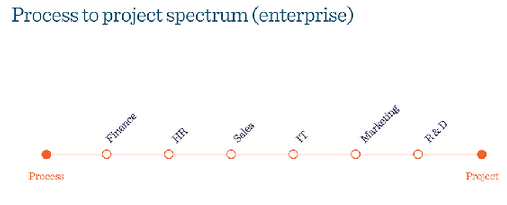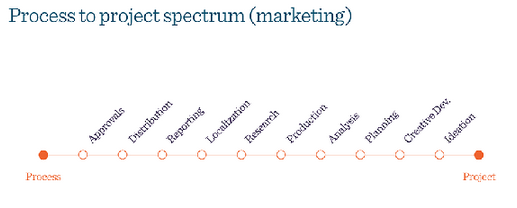
James Gross is the co-founder of Percolate, a platform building the system of record for marketing.
Walk into any company, and ask the person at the front desk, “What department do the creative people work in?”
The answer you’ll most likely hear is “marketing.” Marketing and advertising are widely regarded as creative professions. IT directors make a career ensuring data does the same, safe thing every time. Creative directors, on the other hand, make a career by never repeating the same great idea twice.
But if creativity is about coming up with new and different solutions to complex problems, how do people, brands, and products distinguish themselves as consistently, even audaciously creative? How do firms like Pixar or Wieden + Kennedy keep recreating the magic?

As the graph above shows, different jobs fall on a spectrum from process (do the same thing every time) to project (do a different thing every time). For example, finance is very process-driven, or low variance. You don’t do creative accounting for one really simple reason: It’s probably illegal.
On the other end sits high-variance work. In R&D, every project looks for an entirely different outcome. Marketing and advertising also embrace this novelty, focusing on campaigns, big ideas and never-been-done-before projects that win the hearts and minds of consumers.
However, the more you break down a creative process like marketing, the more you notice there’s still a lot of process and repetition. You don’t use a new brief template for every campaign or change the logo, font and color palette for each creative asset. Great advertising may start with a canvas, but it doesn’t originate from a free-for-all.
Marketing actually has its own system to channel creativity, which also falls along a variance spectrum:

Let’s consider a campaign as an example. While every campaign is unique to the brand, purpose and agencies behind it, each one also shares some common, core attributes: a brief that outlines a strategy and a set of objectives, a team that executes against those objectives, creative elements that will be deployed out into the world, one or more channels where the creative will run, an approval process to ensure the campaign output is correct, and some measurement criteria to report on the campaign’s success.
These shared traits are why strategic frameworks work. It’s also why, contrary to popular belief, even creativity has a system. At film and animation studio Pixar, every project begins with the same team structure — director, writer, artists and storyboarders — following the same process to build team chemistry and incubate a successful movie pitch.
As a CMO or agency lead, one of the most valuable contributions you can make to your organization is to develop a similar system so you can hire the smartest people possible and guide them to produce their best work. Even on the project or campaign side of marketing, systems designed around creative considerations, audiences, visual identity, channels and budgets let everyone work smarter and faster.
There is also a bigger opportunity than ever before for technology to provide us with a better system for creativity. Software can provide creatives more efficient templates to start from and automate away repetitive tasks that aren’t a good use of a person’s time. Thanks to technology, we don’t have to transcribe campaign results by hand — instead, we just export .CSV files from our analytics software. But we definitely still want experienced humans to look at the results.
Traditionally, when we think of technology in marketing, we think of tools that scale and repeat reach. But what’s particularly exciting to me is designing systems across the entire creative process to enhance, enrich and accelerate previously uncharted areas like brief development, planning and creative approvals.
Don’t put smart, inventive people in an environment that distracts them with dumb work — set them free instead. Creativity is a system, one where you want the right technology working in concert with the most creative people you have.
More in Marketing

Marketers are keen to use generative AI in ad campaigns, but hidden costs lurk
Marketers across the industry want to use AI to cut down on time spent in creative production. It’s not so simple in practice.

2025 was rough for Target. It could also be the year when its turnaround began
Much of the front half of the year for Target was defined by the company’s decision in January to pull back on DEI initiatives.

How brands shifted marketing and media strategies through year of tariffs
Marketers share how they navigated the maze of tariffs and regulatory changes this year.





